Let’s walk through the entire process, step by step.
From getting your website approved for AdSense, all the way to crossing the $100 payment threshold.
That’s the first time hard cash will hit your account.
5 Steps to Add AdSense to Your Website
We’re going to show you what this looks like on a site we built on WordPress.
Don’t worry if you are not using WordPress. It’s going to be the same basic process regardless of the website builder you use.
Step 1: Verify Website Ownership
The first step is connecting your website to AdSense and proving to Google that you own it.
If you haven’t already, create a Google AdSense account.
You can create an account without a website, but we are assuming you have one.
Fill out all the information. Agree to the terms and conditions, and make sure your website domain information is correct.
Click Submit.
This will prompt you to verify that you own the website.
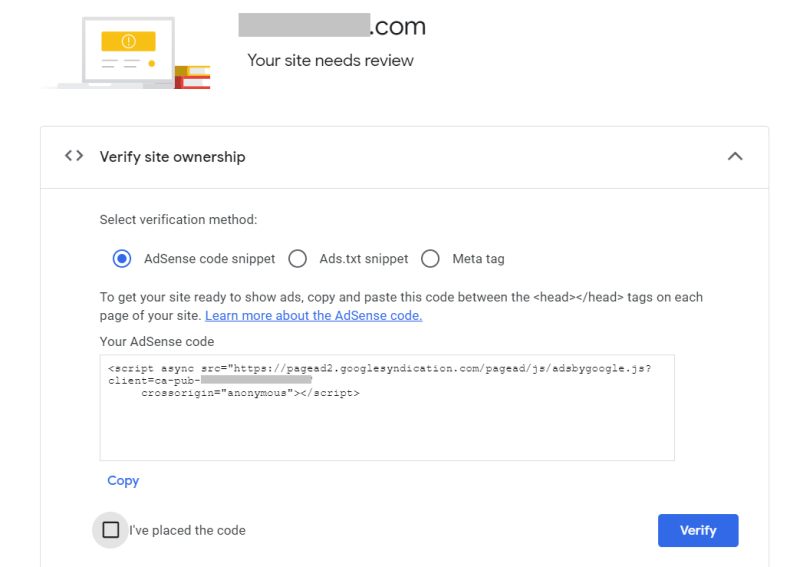
There are three verification methods you can use. Each one relies on adding a small bit of code or text to the source code of your website.
Copy the AdSense code snippet, Ads .txt snippet, or Meta tag, and paste it into your site as directed.
We used the “AdSense code snippet” to verify our WordPress site, which Google told us we should place:
- Between the <HEAD></HEAD> tags
- On each page of our site
Okay, great. So where is this head section to paste the code?
It depends on your WordPress theme, but it’s usually pretty easy to find. Some common places to look in the WordPress admin panel:
- Theme Settings > Header Settings
- Appearance > Theme File Editor > header.php
- Appearance > Widgets > Header section
If none of these get you to the head section, just Google: “header settings + [your WordPress theme]” and you’ll find the answer.
We ended up using Widgets to add the code on our site, which is really common. Here’s what you have to do in that case.
With the AdSense code snippet copied, open the WordPress admin dashboard.
Select Appearance > Widgets and look for the Custom HTML widget.
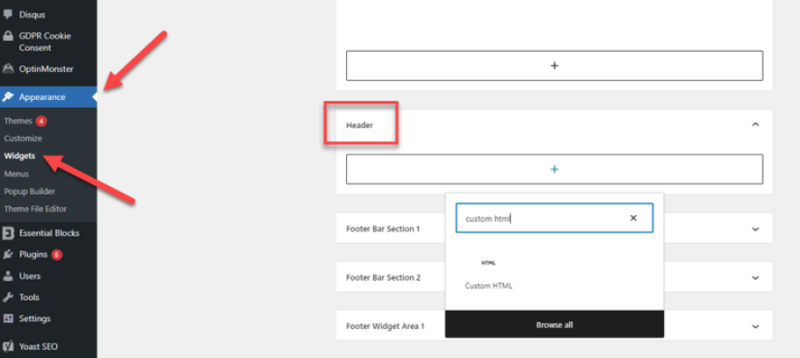
Now Add a Custom HTML block to the Header widget area.
Paste the AdSense code snippet into the Custom HTML block:
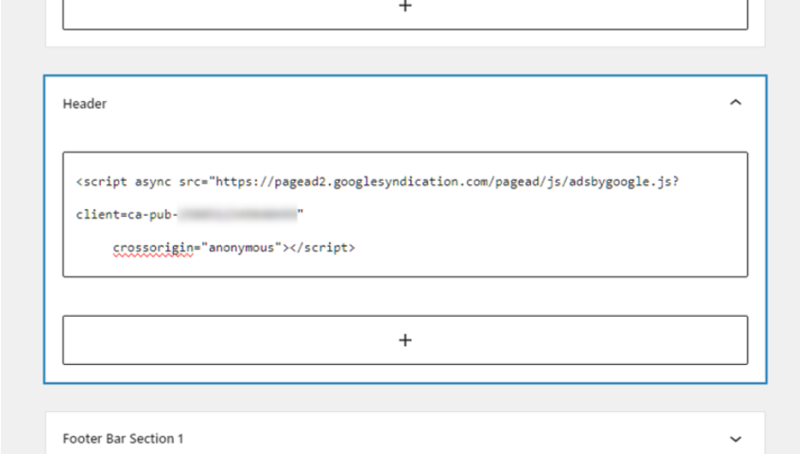
Click Update.
You have added the verification code snippet to between the <HEAD> tags, as AdSense requires. And, since you have updated the appearance, this change occurs on every page of your site.
Return to your AdSense account and click Verify once the AdSense code is live on your site.
Done.
Now Google knows you are the owner, and it can start crawling your site to make sure it’s eligible for inclusion in the AdSense network.
What if I have password protected pages?
Great question. Google won’t be able to crawl those, which could slow down the approval process.
Here’s how you grant Adsense ads crawler access to log-in protected pages.
Can I use a plugin to add AdSense to my site?
Sure. Plenty of people do, and they love it.
There are even plugins from Google and their partners that come as part of an AdSense WordPress starter kit.
Personally, I don’t add WordPress plugins unless I absolutely have to.
Using a plugin just to add a few snippets of code to your header? That’s so unnecessary when the header is usually pretty easy to find and edit.
Plus, the extra plugin could cause real confusion too since there would be two header sections to keep track of. I’ve personally run into this on other theme setups.
The less plugins on your site, the better, and I will die on that hill.
Step 2: Pass Eligibility Review
The website review process may take a few days or up to several weeks.
During that time, Google will be checking to make sure your site meets the eligibility requirements for AdSense.
If you are focused on building an amazing website for your readers, then you are going to knock the eligibility requirements out of the park.
Here’s the gist of what Google wants to see:
Your website needs to be easy to navigate
The text should be readable and aligned properly. Navigation bars should be helpful. Menus should take users to the correct content. Google will flag you for deceptive or illogical navigation that could confuse website visitors.
The traffic on your website is real:
Advertisers need to know their ads are being displayed to real people. Google knows what valid traffic from real users looks like, and will flag you for bad traffic sources or fake traffic.
Your website has 50+ pages of original content:
Google wants to see new, up-to-date, original content that users stick around to read. They don’t want to see the same content repeated on your site, or find a bunch of content scraped from other sites.
There’s no hard fast rule about exactly how many pages of content you need, or what the minimum word count is for a page to be considered “good quality”.
Let’s just say:
- We’re surprised if Google won’t approve a website with 50 pages of good content.
- We’re not shocked if Google won’t approve a website with 20 pages of thin content
Don’t worry about hitting a certain number of pages–just publish new stuff every week.
Don’t spin your tires about word counts–focus on providing helpful content, and thousands of words will come naturally.
Okay–that’s basically it.
You can check out the full eligibility requirements for AdSense. Google is really candid about what they are looking for and what will not be approved.
Once the site review starts, you can track the status of your application in your AdSense account.
A “Getting Ready” status means that Google is still running checks on your site.
Eventually you will get a “Ready” status, which means your site has been approved.
If the status changes to “Needs Attention”, it means your site is not hitting the eligibility requirements. Review the reasons for not getting approval–Google will tell you what’s wrong. Make the required changes, and take another shot at approval.
Step 3: Update Your Website Privacy Policy
Before adding your first AdSense ad, you will want to update your website privacy policy.
If you don’t have any sort of privacy policy, now is definitely the time to create it.
Check out the guidance on AdSense privacy policies and the specific language you should include. Bear in mind that the country or state you live in may require additional provisions in your privacy policy.
Do people run websites with AdSense without privacy policies?
Yes, though it is supposed to have been mandatory to have one since 2023.
From what we can tell, there seems to be a gray area about privacy policies, but it’s shrinking.
For example, in order to comply with GDPR and show ads to users from Europe, you will have to upload the page URL of your privacy policy. There’s no way around that.
Feel free to try and get approved without it. If other websites with AdSense in your niche are getting away without one, maybe you can, too.
But creating a privacy policy is not a huge lift. Plus, it seems like Google is trending towards making this a must-have.
Check out our guide to website privacy policies, which has some examples you can steal.
Step 4: Create Sidebar Ads on Blog Posts
You have total flexibility about where ads go, but let’s be honest: AdSense is a “set it and forget it” style of monetization where you make cash by having a lot of ads on a lot of pages.
Manually adding and tracking thousands of ads sounds awful.
What we recommend instead is adding AdSense ads to the sidebar of every blog post.
This is a popular place to put ads. It won’t really disturb website visitors or break up your content.
Plus it is incredibly easy to add elements to the sidebar, regardless of your website builder. Almost every blog post template ever created has a sidebar built in. If not, it’s usually point and click to add one.
On WordPress, most themes have a sidebar widget area already, so nothing needs to get tweaked in the design.
You add one code snippet to your theme, now all your blog posts have ads in the sidebar.
The blog post sidebar is an easy sweet spot to hit: you get ads on a ton of pages without having to do a whole lot of work.
Okay–let’s create an ad that will fit into your blog post sidebar and add it to a WordPress site.
First, navigate to the Ads section of your AdSense Account, select the By Ad Units tab.
Select Display ads to create a new display ad unit. There are other types you can use, but display is the easiest to use.
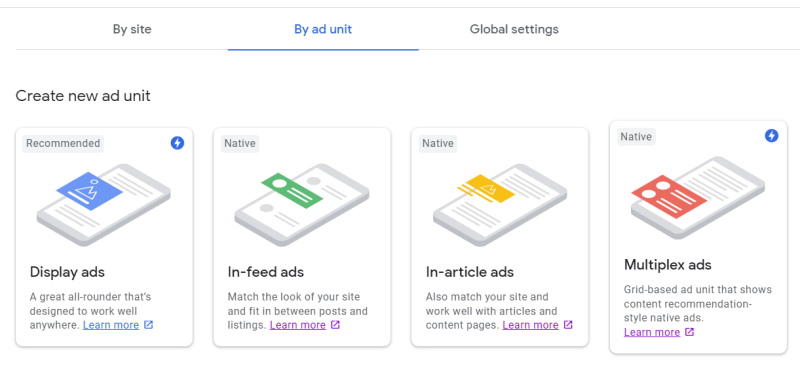
Then configure the ad unit so it will fit appropriately on your site.
You can leave the Ad size as Responsive if you don’t know exactly which dimensions will work.
If you know the size you want, select Fixed and enter the width and height.
In the example, we went for the widely-used ad size known as the “Skyscraper Ad”, which is 120 pixels wide by 600 pixels tall.
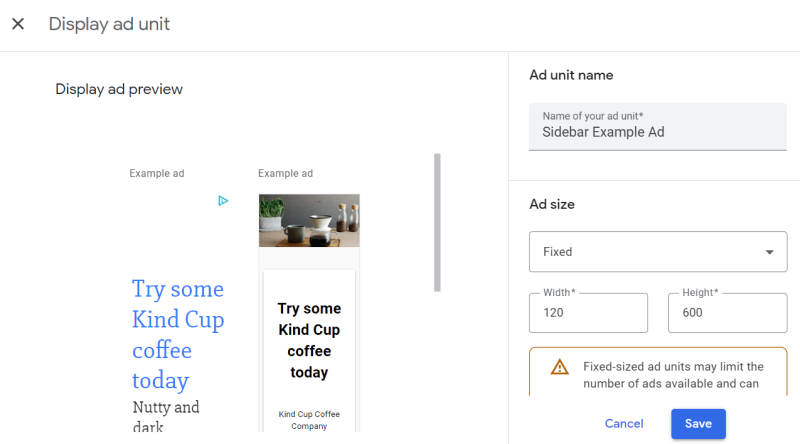
Stick to widely-used ad sizes. Google has lots of data on which ad sizes work well.
Once the dimensions are correct, click Create.
This will open up a new page with an Ad unit code snippet.
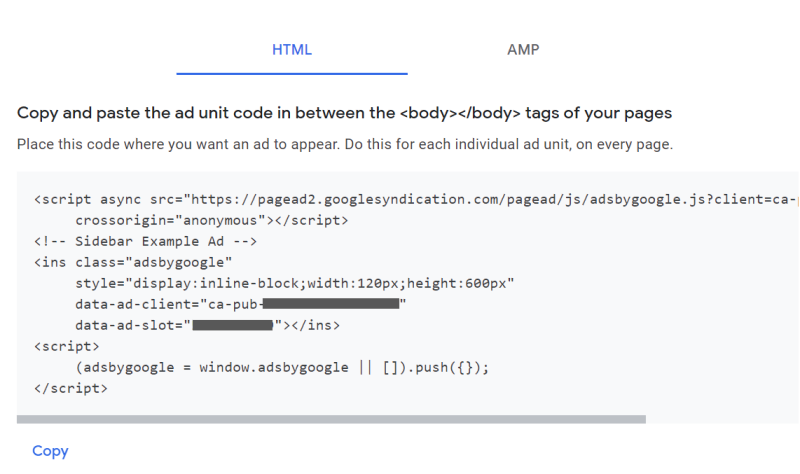
Copy the code and then open your WordPress Admin dashboard and so you can add it to the theme.
On our WordPress site, it’s nearly the same process we used to add the verification code, but there is one key difference:
- Open WordPress admin panel
- Go to Appearance > Widgets
- Add Custom HTML block into the sidebar widget area (NOT the header area)
- Paste the Auto Ads code snippet into the Custom HTML block.
- Click Save
In this case, we want to add the code snippet snippet to the sidebar widget area, not the header area.
That’s it. Within 20 minutes or so, ads will start showing up on your website.
What if these steps don’t work?
Because WordPress themes are different, your steps are likely to be a little different. You may have to check in Theme Settings as opposed to Appearance in order to find the appropriate spot to add the code.
It’s usually pretty straightforward for most blog post templates, but if you get stuck, just Google “Add sidebar code [your WordPress theme]”.
Step 5: Set Up AdSense Payment
Once the ads are live, you’ll start to see your estimated earnings go up on the Reports page of your AdSense account.
When your revenue hits the verification threshold ($10), you will need to verify your identity and address with Google.
Then, once your revenue hits the payment threshold, you will be allowed to select your form of payment and connect a bank account.
For publishers in the United States, the payment threshold is $100. See Google’s complete breakdown of the verification and payment process, as well as the payment thresholds for different countries.
Once you hit the revenue threshold, you will be sent a PIN by mail. This will take 2-3 weeks to arrive at the address you verified earlier.
Follow the instructions for verifying your PIN in your Google AdSense account and setup payments.
Congratulations–you are about to receive your first payment from AdSense.
Can People Make A Lot Of Money With AdSense?
Yes.
If you have a website with great content and an absurd volume of traffic, then you can make tons of money.
Publishers who are serious about driving revenue with AdSense usually have a portfolio of websites–not just one–and they have done keyword research to make sure their website content covers lucrative topics with actual traffic.
If you have a single small site or a brand new site without a lot of content, then AdSense is going to generate pocket-change revenue. At least for the first few months.
Let’s sketch the ground rules for payment and do some back of the envelope math.
- Google AdSense pays based on impressions, which are the number of times your ad is shown to a visitor. (Publishers currently get paid per click, but AdSense is moving to paying per impression, so that’s what we’re preparing people to expect)
- AdSense publishers track their RPM, which stands for revenue per mille, which refers to the revenue generated per thousand impressions. The word “mille” is Latin for “one thousand.”
- RPM varies widely from site to site. On the low end, websites might see a $0.50 RPM, or less. Established sites, especially those that publish a lot of original content, may hit an RPM of $10, $20, $40, or more.
- For our quick calculations, we’ll use a $5 RPM, which is comfortably average.
Here’s what you could get:
- $100/month = 20,000 impressions with a $5 RPM
- $1,000/month = 200,000 impressions with a $5 RPM
- $10,000/month: 2,000,000 impressions with a $5 RPM
You can see why having traffic is the key to making money with AdSense. More visitors to your site means more impressions.
If you can boost RPM, you can make more money on the same amount of traffic. You can show more ads, better placed ads, higher converting types of ads, and so on.
Of course, if your content is really great, people will stick around and read it. They’ll see tons more ads as they scroll.
Showing advertisements is not our monetization strategy on Quick Sprout, as you can tell, but is it a viable way to make money?
Absolutely.
The best way to learn is by doing, and who cares if it takes a few months to get to your first $100. There is a lot more where that came from.
Trillions of impressions are up for grabs. You just need to build content and drive traffic.
Here are some posts we’ve written that go way deeper into what it takes to create content and increase traffic:
- The Step-by-Step Guide to Creating Scannable Content
- How to Write Guest Posts That Drive Traffic to Your Website
- The 7 Best (and Only) Ways To Increase Website Traffic
- A Step-by-Step Guide to Driving 10,000 Visitors a Month Through Pinterest
Website owners who publish vital content and useful resources will win traffic over the long run.
